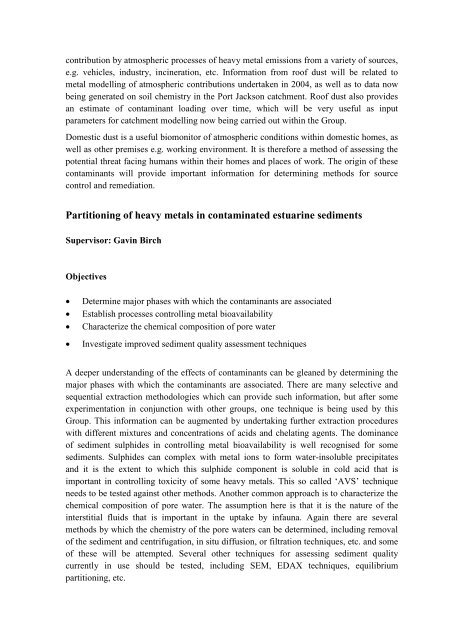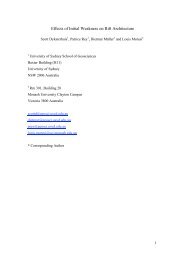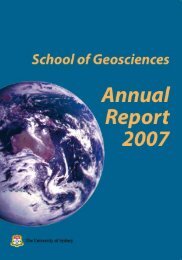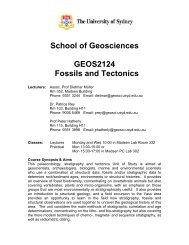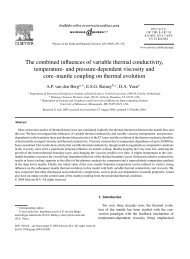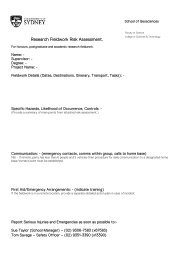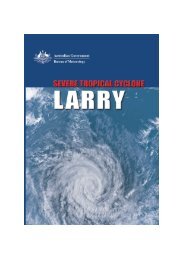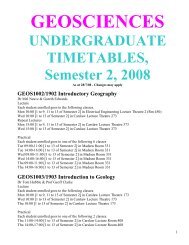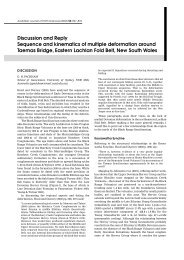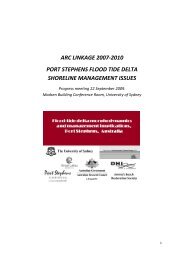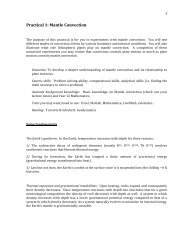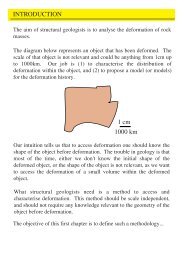Gavin Birch - School of Geosciences
Gavin Birch - School of Geosciences
Gavin Birch - School of Geosciences
Create successful ePaper yourself
Turn your PDF publications into a flip-book with our unique Google optimized e-Paper software.
contribution by atmospheric processes <strong>of</strong> heavy metal emissions from a variety <strong>of</strong> sources,<br />
e.g. vehicles, industry, incineration, etc. Information from ro<strong>of</strong> dust will be related to<br />
metal modelling <strong>of</strong> atmospheric contributions undertaken in 2004, as well as to data now<br />
being generated on soil chemistry in the Port Jackson catchment. Ro<strong>of</strong> dust also provides<br />
an estimate <strong>of</strong> contaminant loading over time, which will be very useful as input<br />
parameters for catchment modelling now being carried out within the Group.<br />
Domestic dust is a useful biomonitor <strong>of</strong> atmospheric conditions within domestic homes, as<br />
well as other premises e.g. working environment. It is therefore a method <strong>of</strong> assessing the<br />
potential threat facing humans within their homes and places <strong>of</strong> work. The origin <strong>of</strong> these<br />
contaminants will provide important information for determining methods for source<br />
control and remediation.<br />
Partitioning <strong>of</strong> heavy metals in contaminated estuarine sediments<br />
Supervisor: <strong>Gavin</strong> <strong>Birch</strong><br />
Objectives<br />
<br />
<br />
<br />
<br />
Determine major phases with which the contaminants are associated<br />
Establish processes controlling metal bioavailability<br />
Characterize the chemical composition <strong>of</strong> pore water<br />
Investigate improved sediment quality assessment techniques<br />
A deeper understanding <strong>of</strong> the effects <strong>of</strong> contaminants can be gleaned by determining the<br />
major phases with which the contaminants are associated. There are many selective and<br />
sequential extraction methodologies which can provide such information, but after some<br />
experimentation in conjunction with other groups, one technique is being used by this<br />
Group. This information can be augmented by undertaking further extraction procedures<br />
with different mixtures and concentrations <strong>of</strong> acids and chelating agents. The dominance<br />
<strong>of</strong> sediment sulphides in controlling metal bioavailability is well recognised for some<br />
sediments. Sulphides can complex with metal ions to form water-insoluble precipitates<br />
and it is the extent to which this sulphide component is soluble in cold acid that is<br />
important in controlling toxicity <strong>of</strong> some heavy metals. This so called ‘AVS’ technique<br />
needs to be tested against other methods. Another common approach is to characterize the<br />
chemical composition <strong>of</strong> pore water. The assumption here is that it is the nature <strong>of</strong> the<br />
interstitial fluids that is important in the uptake by infauna. Again there are several<br />
methods by which the chemistry <strong>of</strong> the pore waters can be determined, including removal<br />
<strong>of</strong> the sediment and centrifugation, in situ diffusion, or filtration techniques, etc. and some<br />
<strong>of</strong> these will be attempted. Several other techniques for assessing sediment quality<br />
currently in use should be tested, including SEM, EDAX techniques, equilibrium<br />
partitioning, etc.


